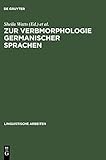Zur Verbmorphologie germanischer Sprachen / hrsg. von Sheila Watts, Jonathan West, Hans-Joachim Solms.
Material type: TextSeries: Linguistische Arbeiten ; 446Publisher: Tübingen : Max Niemeyer Verlag, [2013]Copyright date: ©2001Edition: Reprint 2013Description: 1 online resource (237 p.) : 12 KtnContent type:
TextSeries: Linguistische Arbeiten ; 446Publisher: Tübingen : Max Niemeyer Verlag, [2013]Copyright date: ©2001Edition: Reprint 2013Description: 1 online resource (237 p.) : 12 KtnContent type: - 9783484304468
- 9783110918656
- online - DeGruyter
- Issued also in print.
| Item type | Current library | Call number | URL | Status | Notes | Barcode | |
|---|---|---|---|---|---|---|---|
 eBook
eBook
|
Biblioteca "Angelicum" Pont. Univ. S.Tommaso d'Aquino Nuvola online | online - DeGruyter (Browse shelf(Opens below)) | Online access | Not for loan (Accesso limitato) | Accesso per gli utenti autorizzati / Access for authorized users | (dgr)9783110918656 |
Frontmatter -- Inhaltsverzeichnis / Table of Contents -- Abkürzungsverzeichnis / List of Abbreviations -- Zur Verbmorphologie germanischer Sprachen -- Strong verb Ablaut in the West Germanic languages -- The lengthened grade in the Germanic 4th and 5th class strong verbs -- On the origin of ū in verbs of the type lūkan -- Zur westmitteldeutschen ,Wechselflexion‘ bei den mhd. starken Verben der Klassen III–V -- The Newcastle Germanic Weak Verbs Project: Conjectures on the weak preterite -- Zum Formenbestand des Verbalparadigmas im Gotischen und im Althochdeutschen: Indogermanische Archaismen und germanische Innovationen -- Aspect and tense from PIE to Germanic: The systemic evolution -- Peculiarities of verbal classes in German, particularly in relation to English and Dutch -- How to become an auxiliary: Progressive and perfect in Old Saxon -- Diachronie und Synchronie von auxiliarem tun im Deutschen -- Lexical and periphrastic DO in Early New High German -- Zum frühneuhochdeutschen Ausdruck der Aktionsart im Präteritum beim steirischen Dichtermönch Andreas Kurzmann um 1400 -- Three modal verbs -- The German tense-aspect-mood system from a typological perspective -- The Old Low German verb as a token of linguistic identity
restricted access online access with authorization star
http://purl.org/coar/access_right/c_16ec
Der altgermanischen Sprachen Gotisch, Altnordisch und Altsächsisch bis hin zu den modernen Sprachen Niederländisch, Englisch und Deutsch als Datenquellen bedienen sich die in diesem Buch erscheinenden Beiträge zur historischen Verbmorphologie. Besondere Berücksichtigung finden Themen wie die Ursprünge der starken und schwachen Verben, die Entwicklung grammatischer Kategorien im Bereich Tempus-Aspekt-Modus und sowohl deren morphologischen bzw. syntaktischen Markierung als auch deren Implikationen für die Semantik der Verbalphrase. Die Aufsätze gehen über die Beschreibung der Phänomene hinaus, indem sie sich theoretischen Fragen stellen, ohne daß sich das Buch jedoch auf nur eine bestimmte Theorie beschränkt. Die Diskussionen zur Rekonstruktion, Typologie und Analogie sowie der Grammatikalisierung, Ergativität und Polarität des germanischen Verbs werfen ein neues Licht auf die diversen Formen seiner grammatischen und semantischen Funktionen.
The Germanic languages from Gothic, Old Norse and Old Saxon to modern Dutch, English and German are the source of data for this collection of articles on diachronic verbal morphology. Central questions are the origins of strong and weak verbs, the development of tense, aspect and mood categories, and both their formal morphological or syntactic marking, and their implications for the semantics of the verb phrase. The articles are all theoretically informed, albeit from a wide range of frameworks, and issues of reconstruction, typology and analogy are discussed alongside grammaticalization, ergativity and polarity in order to shed new light on the diverse forms and functions of the Germanic verb.
Issued also in print.
Mode of access: Internet via World Wide Web.
In German.
Description based on online resource; title from PDF title page (publisher's Web site, viewed 28. Feb 2023)


